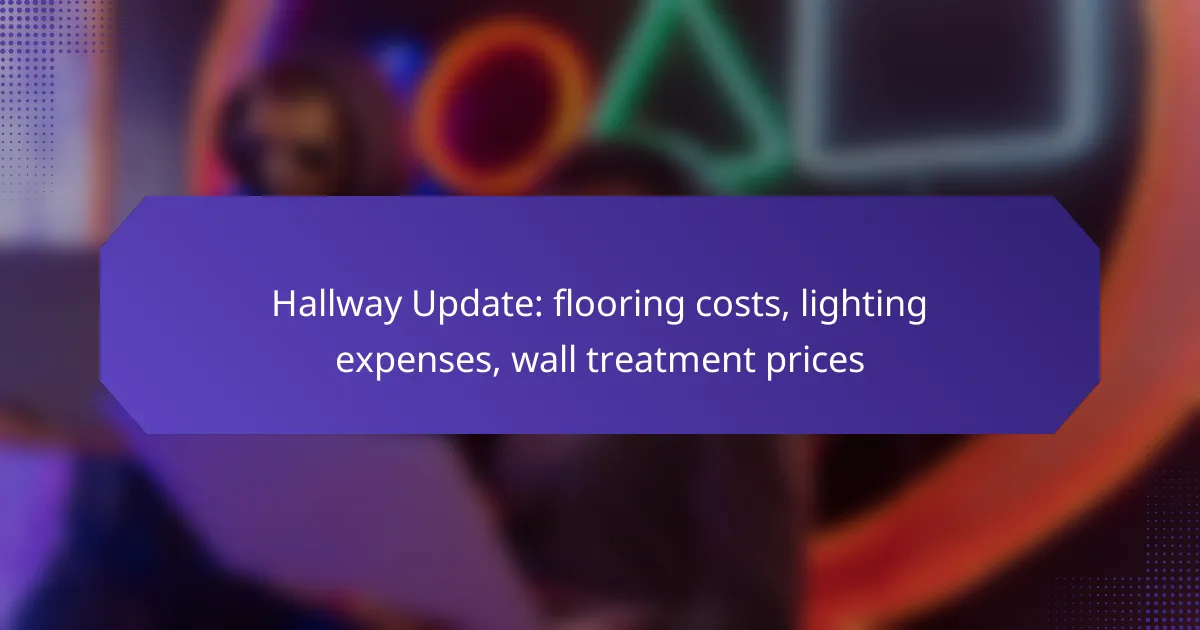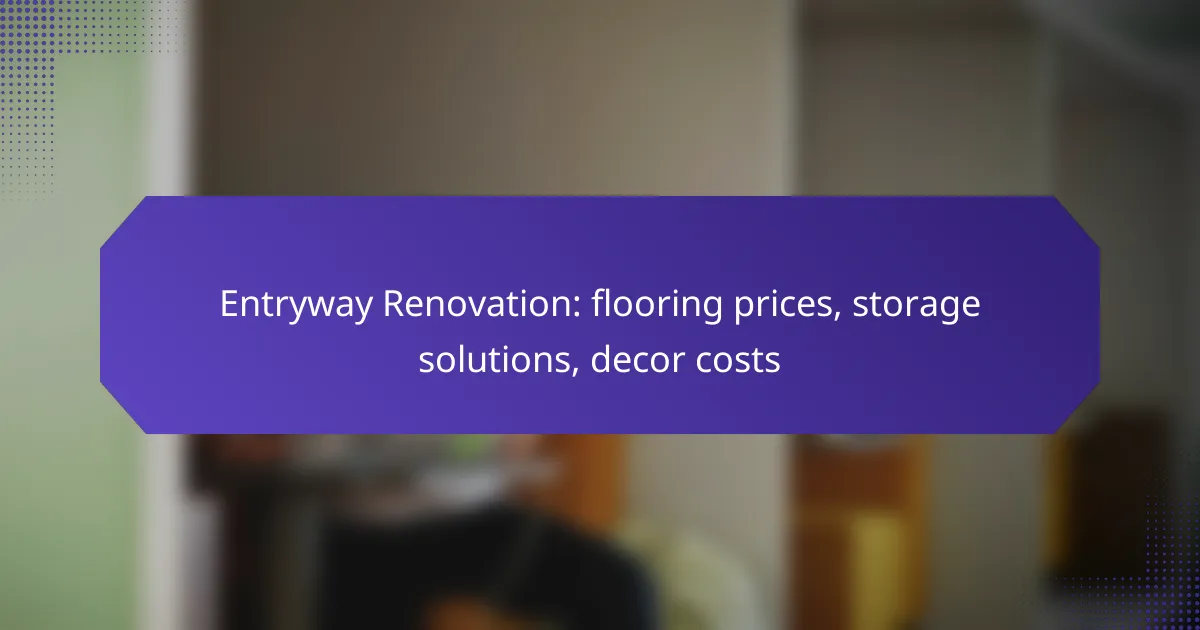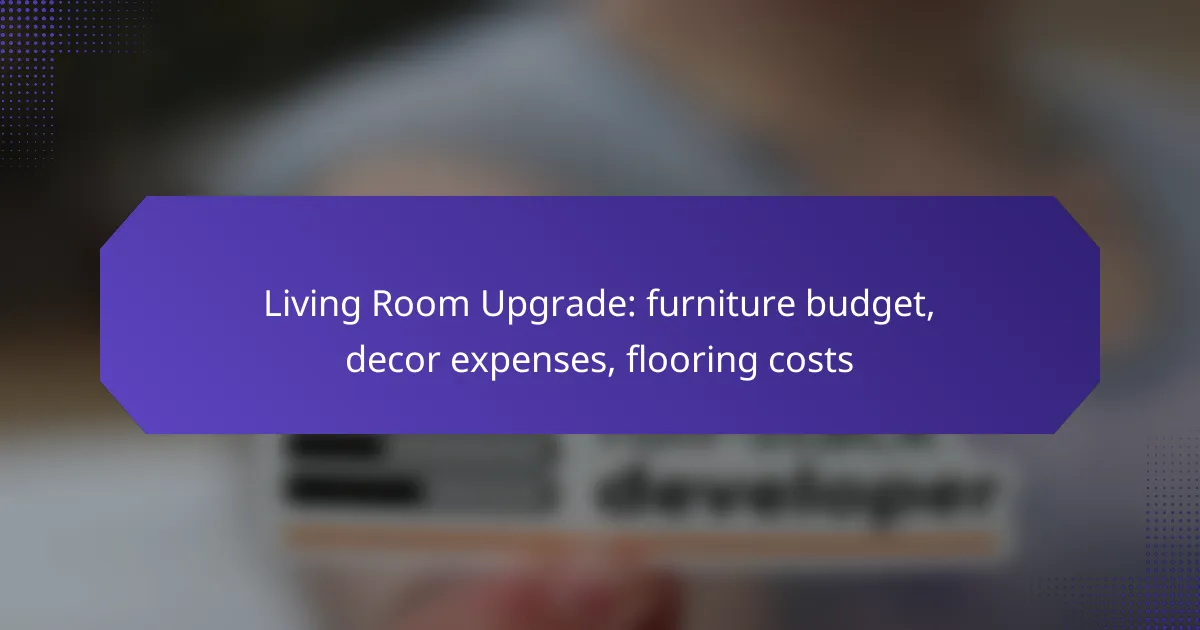Updating your hallway can enhance both its aesthetic appeal and functionality, but costs can vary widely based on several factors. Flooring expenses may range from a few to over twenty dollars per square foot, while lighting can set you back anywhere from a few hundred to several thousand dollars, depending on your choices. Additionally, wall treatments can also vary significantly, with prices typically falling between a few hundred to several thousand dollars based on the materials and installation methods selected.

What are the flooring costs for hallway updates in the US?
The flooring costs for hallway updates in the US can vary significantly based on the material chosen, installation method, and regional labor rates. Generally, homeowners can expect to spend anywhere from a few dollars to over twenty dollars per square foot, depending on these factors.
Average cost per square foot
The average cost per square foot for hallway flooring typically ranges from $3 to $15. This range reflects various materials, with lower-end options like vinyl and laminate being more affordable, while higher-end choices like hardwood and tile can be more expensive. It’s essential to consider both the material and the quality when estimating costs.
Cost comparison of hardwood, laminate, and tile
Hardwood flooring usually costs between $8 and $15 per square foot, offering durability and aesthetic appeal. Laminate flooring is a budget-friendly alternative, generally priced between $1 and $5 per square foot, making it a popular choice for cost-conscious homeowners. Tile flooring can range from $3 to $10 per square foot, with ceramic being less expensive than natural stone options.
Installation fees and labor costs
Installation fees for flooring can add significantly to the overall cost, often ranging from $1 to $5 per square foot. Labor costs can vary based on location and the complexity of the installation. It’s advisable to obtain multiple quotes from contractors to ensure competitive pricing and to consider DIY options if you have the skills and tools necessary.

What are the lighting expenses for hallway updates in the US?
The lighting expenses for hallway updates in the US can vary significantly based on the type of lighting chosen, installation complexity, and fixture selection. Homeowners should expect to spend anywhere from a few hundred to several thousand dollars depending on these factors.
Average cost of LED vs. traditional lighting
LED lighting typically costs more upfront than traditional incandescent or fluorescent options, but it offers significant savings in energy consumption and longevity. The average price for LED bulbs ranges from $5 to $15 each, while traditional bulbs can be found for $1 to $3.
When considering long-term costs, LED lights can reduce energy bills by about 75% compared to traditional lighting, making them a more economical choice over time. Additionally, LEDs last up to 25,000 hours, while traditional bulbs may only last about 1,000 hours.
Installation costs for recessed lighting
Installing recessed lighting can cost between $100 and $300 per fixture, depending on the complexity of the installation and the type of housing used. This price often includes both the fixture and labor costs.
Homeowners should consider that additional expenses may arise if electrical work is needed or if existing ceilings require modifications. It’s advisable to hire a licensed electrician to ensure compliance with local building codes and safety standards.
Cost of decorative fixtures
The cost of decorative fixtures can vary widely, ranging from $50 to over $500 per piece. Factors influencing the price include the material, design complexity, and brand reputation.
When selecting decorative fixtures, consider both aesthetics and functionality. Opting for energy-efficient models can provide savings in the long run, while unique designs can enhance the overall look of the hallway. Always check for warranties and return policies when purchasing high-end fixtures.

What are the wall treatment prices for hallway updates in the US?
Wall treatment prices for hallway updates in the US can vary significantly based on the type of treatment chosen. Homeowners typically spend anywhere from a few hundred to several thousand dollars depending on materials and installation costs.
Average cost of paint per gallon
The average cost of paint per gallon in the US ranges from $15 to $60, depending on the brand and quality. For a standard hallway, you may need 2 to 3 gallons, leading to a total paint cost of approximately $30 to $180.
When selecting paint, consider factors like finish and durability. Higher-quality paints may cost more upfront but often provide better coverage and longevity, reducing the need for frequent repainting.
Cost of wallpaper installation
Wallpaper installation costs can range from $0.50 to $3.00 per square foot, depending on the complexity of the design and the type of wallpaper. For an average hallway of about 200 square feet, this translates to a total cost of $100 to $600 for materials and labor.
Keep in mind that additional costs may arise from wall preparation or removal of old wallpaper. Choosing peel-and-stick options can simplify installation and reduce labor costs.
Pricing for wainscoting and paneling
The cost of wainscoting and paneling can vary widely, typically ranging from $1.50 to $10.00 per square foot. For a hallway, this could mean spending anywhere from $300 to $2,000, depending on the materials used and the complexity of the installation.
When considering wainscoting, think about the style and material that best fits your home. Wood is a popular choice, but MDF and PVC options can be more budget-friendly and easier to maintain.

How to choose the right flooring for your hallway?
Choosing the right flooring for your hallway involves considering factors like durability, maintenance, and aesthetic appeal. The right choice can enhance the space’s functionality while complementing your home’s design.
Factors to consider for material selection
When selecting flooring materials for your hallway, consider foot traffic levels, moisture exposure, and style preferences. High-traffic areas benefit from durable materials like tile or hardwood, while moisture-prone spaces may require water-resistant options like vinyl or laminate.
Additionally, think about the overall design of your home. For a modern look, sleek tiles or polished concrete may work best, while traditional homes might suit hardwood or patterned vinyl. Budget is also a key factor; flooring costs can range from low to high depending on the material chosen.
Durability and maintenance considerations
Durability is crucial for hallway flooring due to constant use. Materials like porcelain tile and engineered hardwood are known for their resilience and can withstand heavy foot traffic. In contrast, softer materials like carpet may wear out more quickly in these areas.
Maintenance requirements vary by material. For instance, tile is easy to clean but may require grout maintenance, while hardwood needs periodic refinishing. Consider your lifestyle and how much time you can dedicate to upkeep when making your choice.

What are the best lighting options for hallways?
The best lighting options for hallways combine functionality and aesthetics, ensuring safety while enhancing the space’s appearance. Consider using a mix of ambient, task, and accent lighting to achieve a well-lit and inviting hallway.
Energy-efficient lighting solutions
Energy-efficient lighting solutions, such as LED bulbs and fixtures, are ideal for hallways due to their long lifespan and low energy consumption. LEDs can reduce energy costs by up to 80% compared to traditional incandescent bulbs.
When selecting energy-efficient options, look for products with the ENERGY STAR label, which indicates they meet strict efficiency guidelines. Additionally, consider using motion sensors or dimmers to further enhance energy savings.
Best brands for hallway lighting
Some of the best brands for hallway lighting include Philips, GE, and Cree, known for their reliable and stylish options. Philips offers a wide range of LED fixtures that are both energy-efficient and aesthetically pleasing.
For budget-friendly choices, consider brands like Hyperikon and Lithonia Lighting, which provide quality products at competitive prices. Always check customer reviews and warranty options to ensure you’re making a sound investment in your hallway lighting.

What are the latest trends in wall treatments for hallways?
Current trends in wall treatments for hallways focus on enhancing aesthetics and functionality. Popular options include bold colors, textured finishes, and eco-friendly materials that create a welcoming atmosphere while ensuring durability.
Popular color schemes for 2024
For 2024, color schemes in hallway wall treatments emphasize earthy tones and vibrant accents. Shades like terracotta, deep green, and soft beige are gaining traction, offering warmth and sophistication.
Accent walls featuring brighter colors, such as mustard yellow or navy blue, can create focal points that draw the eye. When selecting colors, consider the natural light in the hallway, as it can significantly affect how colors appear.
Innovative materials and textures
Innovative materials for hallway wall treatments include sustainable options like reclaimed wood and bamboo, which add character while being environmentally friendly. Textured finishes, such as 3D wall panels or plaster, can create visual interest and depth.
Additionally, wallpaper with unique patterns or textures is making a comeback, allowing for personalization. When choosing materials, consider maintenance and durability, especially in high-traffic areas where wear and tear are common.

How do hallway updates impact home value?
Hallway updates can significantly enhance a home’s value by improving aesthetics and functionality. A well-designed hallway creates a welcoming atmosphere and can influence potential buyers’ perceptions, often leading to quicker sales and higher offers.
Flooring costs
Flooring is a critical aspect of hallway updates, with costs varying based on materials and installation. Common options include hardwood, laminate, tile, and carpet, with prices typically ranging from $2 to $10 per square foot, excluding installation fees.
When selecting flooring, consider durability and maintenance. For high-traffic areas like hallways, materials such as tile or hardwood may offer better longevity compared to carpet. Additionally, factor in the cost of underlayment and any necessary repairs to the subfloor.
Lighting expenses
Lighting plays a vital role in enhancing the hallway’s ambiance and functionality. The cost of lighting fixtures can range from $30 for basic options to several hundred dollars for designer pieces. Installation costs may add another $50 to $150, depending on the complexity.
Consider energy-efficient LED fixtures to reduce long-term electricity costs. Incorporating dimmers can also provide flexibility in lighting levels, enhancing the hallway’s appeal while being budget-conscious.
Wall treatment prices
Wall treatments, including paint, wallpaper, or paneling, can transform a hallway’s look. Basic paint jobs may cost between $1 to $3 per square foot, while wallpaper can range from $0.50 to $5 per square foot, depending on the design and quality.
When updating wall treatments, choose colors and patterns that complement the overall home decor. Additionally, consider the long-term maintenance of the materials selected, as some options may require more frequent updates or repairs.










